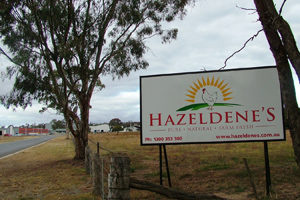Quality awareness is paramount for Hazeldene’s in Australia

The Australian poultry market is relatively small and dominated by two big players and a handful of regional operations. One of these is Hazeldene’s in the southern state of Victoria. The company controls the whole chain from parent stock, hatchery, broiler grow outs to the final products on the supermarket shelve. It just installed a new slaughtering line to modernise and increase production to keep up their high quality standards.
By Dick Ziggers
It is a beautiful but cloudy day when I make my way to Lockwood, a hamlet clinging to the old gold-mining town of Bendigo in Victoria, Australia. Sixteen years ago I drove the same road in pouring rain, stopping at the Tourist Information to get directions. Now the GPS-system is leading me through sleepy towns and gum tree forests. I thought I would encounter a déjà vu considering the prejudice that developments in Australia go a little slower than in the rest of the world, but I am mistaken.
Back then I came for a report on the business of Dick Hazeldene, to write for a Dutch national poultry magazine. I remember he resided in an office that had the appearance of a pawn shop. However, when the friendly lady in my GPS tells me to turn right into Hazeldene Road that memory is shattered to pieces. I am driving on a wide and straight road leading to what looks like a huge industry complex, with a parking lot on the side and a revolving gate to pass before being able to enter the premises. Trucks are backed up to loading docks and people in white outfits with hairnets and gum boots walk from building to building.
Still nothing tells me I am at the largest poultry slaughterhouse in Victoria. I see no movements of broiler trucks, but then I realise that it is nearly lunch time and processing of the birds, which are caught overnight, starts already as early as 2 AM. With 650 employees this is the largest employer in regional Australia. What I am looking at is a new state-of-the-art primary processing plant that is in operation since March 2012. Adjacent is a large value adding plant and at the back a full ‘protein recovery unit’. Hazeldene’s treats poultry by-products as a valuable resource. Bones and downgraded product is sold to the pet food industry and other waste products such as feathers and blood are processed off site. They are converted into feather meal, poultry offal meal and so on. These are sold to a number of manufacturers for further processing. As a result the company has no unusable ‘waste’ chicken after processing.
It all started back in 1957 when Dick Hazeldene began a hatching and egg producing operation. Since that time, the company has developed into Australia’s only fully integrated regional poultry processor. The Australian poultry meat market is dominated by two main privately owned players who have about a 70% market share: Inghams (up for sale since July this year) and Baiada (who bought the Bartter family business with its Steggles brand in 2009). They have farming and processing operations in five and all six states respectively. The balance of the market is supplied by another six medium-sized, privately owned companies, which each supply between approximately 3% and 9% of the national market, and a myriad of smaller processors.
On my first visit in 1996 Dick Hazeldene was already 68 years old and when I asked him about retiring he called in one of his employees and said: “John, when am I going to retire?” John replied with Australian humour: “You’re already dead before you stop working.” So far that didn’t come true. Dick retired in 2004 at the age of 75, but is still around for advice. The business in now managed by his son John and daughter Vicki. A second son, Peter, is a director and part owner, but is not working in the business.
New processing plant
The market for fresh birds is not doing very well, according to farming manager Karl Lawson. “It is the worst market at the moment,” he says. “We had an exceptional summer with very good efficiencies at the farms.” This resulted in good growth and low mortality and thus a surplus of poultry meat on the market, which depresses prices and margins. And margins need to be good; since Hazeldene’s new processing plant required an investment of around A$39 million.
A complete new 13,000 birds per hour Stork equipped slaughtering line has been installed with gas stunning and an aero scalding system. The birds are not immersed in hot water any more, but now heated up with hot air and water to loosen the feathers from the follicles before the carcasses go into the plucker. The idea behind this new system is lowering water use and improved hygiene. The system is very new and Hazeldene’s is only the fourth company to install it. It has to be improved in practice and needs adjustments and fine-tuning. “At the very start plucking was inconsistent but all issues have been addressed with increased water and air pressures which has enabled our bird quality to improve,” Lawson says. And quality is what the processor stands for.
Already in 1996 Dick Hazeldene said that his bird had a better quality than in Europe and that quality consciousness has been passed on to his successors. The new processing line is not yet running at full speed, because the further processing and packaging units are not matched to the increased and faster supply. What I like about the new plant is the elevated walkway at the first level with viewing windows all along, which enables customers and curious visitors like myself to have a look at the whole slaughtering process.
Broiler grow outs
The Australian market processes about 565 million birds, of which some 9% comes out of Hazeldene’s plant. The broilers are raised in about 150 poultry sheds. The farms produce 5.5 to 6 batches per year and two-thirds of the grow out units are owned by the integrator. The remaining one third of birds is managed and supplied by contract growers, who of course receive the day-old chicks out of Hazeldene’s hatchery.
The broilers are killed at different weights and therefore load out of the birds starts around 1.8 kg live weight. This happens up to four times per batch. Approximately 40% remains to grow to a weight of 3 kg and more.In Australia the maximum density in the broiler sheds is set at 40 kg/m2. Hazeldene’s keeps the birds well below the 40 kg/m2; animal welfare organisation RSPCA limits density to 34 kg/m2. In an agreement with Coles supermarkets Hazeldene’s grows these RSPCA birds, which, apart from density requirements, also need to have access to a perch and light intensity is minimised at 20 lux. Furthermore no antibiotics are allowed and essential oils (Crina) are used instead. Since the beginning of this year trials have been set up with flocks that are grown without antimicrobial growth promoters. “So far we don’t see any differences,” Lawson says.
Ridley, Australia’s largest feed manufacturer, supplies all the feed for the broilers and parent stock. The company has three mills in Hazeldene’s area. The feed is made from a multigrain, but mainly wheat based (±40%) recipe. Protein is supplied through soybeans, faba beans and lupines. Processed animal proteins are still allowed in Australia. Hazeldene’s controls the additives that go into the feed and the formulations are reviewed monthly.
Breeding stock
Hazeldene’s controls its own supply of day-old broiler chicks. In 2006 the company commissioned a new state-of-the-art hatchery on a green-fields site in Bendigo East. Equipped with Linco Set & Hatch machines up to 600,000 chicks per week can be supplied. Eggs are transported from company breeder sites to the hatchery where they are stored until being placed into incubators. Once hatched the chicks are transported in specially air conditioned trucks to the broiler farms.
The hatchery is supplied with eggs from the company’s own parent stock farms where two types of breeders are placed: Ross 308 and Arbor Acres. Parent stock is reared at three new rearing farms, each containing three sheds for the hens and one for the roosters. Hazeldene’s is in the process of converting the older previous rearing farms to laying farms, explains breeder manager Wayne Harrington. He has picked me up from the Head office to visit a parent stock farm with four sheds each housing 9,000 birds. This is actually a converted rearing farm. A second farm is in the process of conversion to a laying house, Harrington explains. Before we enter the farm we go through a shower unit and slip into company clothing.
The company owns and runs most of its parent stock farms. One farm with 26,000 hens is contracted out and one company farm with 18,000 hens is owned and managed by John and Vicki. The majority of the breeders, some 140-150,000 birds, are kept on the Vencomatic veranda system, which I unfortunately cannot visit. Although the results with this system are a little bit lower than in floor housing mainly due to holding onto fertility, Lawson previously was very enthusiastic about it, because the cost price of a hatching egg is much lower than in conventional housing.
Harrington takes me around the farm. Inside it is just feeding time. The hens are fed in separation pans, whose openings are too small for the roosters. These are fed on the floor in special pans that are hung at their feeding level, which is too high for the hens to reach. Also feeding space is limited to get some competition among the cockerels. It is the first flock in this converted rearing house and Harrington is pleased with its performance so far. It is not very hot outside so a comfortable climate is relatively easy to manage. Fresh air is controlled by a combination of side inlets and tunnel ventilation. When it gets too hot a pad cooling system steps in. In between two houses an enormous metal water basin is placed to supply the sheds with water. When we finish our tour we exit the farm through the shower unit again. Although it is a daily routine for the farm workers, it is also beneficial, because after work you always go home refreshed.
More information
View the photo gallery on www.worldpoultry.net/Home/Photos
caption: Hazeldene’s is the third largest fully integrated poultry processor in Australia based in Lockwood, a hamlet clinging to Bendigo in the state of Victoria.








